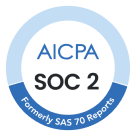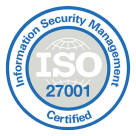
Your Salesforce CRM is powerful, but it’s not complete. While 150k+ companies trust Salesforce to manage their customer relationships, the real magic happens when you connect it to the right tools.
We analyzed 25+ integration tools, studied user reviews, and identified the 12 that deliver measurable results. Companies using these integrations report up to 26% higher productivity1 and dramatically faster deal cycles.
Ready to stop the app-switching chaos and start closing more deals? Here are the integrations that will transform how your team sells in 2025.
Key Takeaways
- The right Salesforce integrations can automate outreach, boost data accuracy, and shorten the sales cycle.
- Sales teams benefit most from tools in five categories: Calling, Email Automation, Contract Management, Data Enrichment, and Collaboration.
- Choose integrations based on ease of setup, data sync quality, and sales use cases, not just popularity.
- Most integrations offer free trials. Test before committing.
See how CloudTalk can boost Salesforce.

What is a Salesforce Integration?
A Salesforce integration connects third-party tools or internal systems to Salesforce, allowing data and workflows to sync seamlessly.
Think of integrations as bridges that connect your favorite tools directly to Salesforce. Instead of jumping between apps to update lead information, log calls, or track email responses, everything flows automatically into your CRM.
Your VoIP system logs call details, your email tool tracks opens and clicks, and your contract software updates deal stages. With a proper Salesforce VoIP integration, your system logs call details automatically, while your email tool tracks opens and clicks, and your contract software updates deal stages.
Real example
With CloudTalk integrated, when a rep calls a lead from Salesforce, the system automatically logs call duration, outcome, and notes directly into that contact’s record.
What if every call automatically updated your Salesforce records?
The 12 Best Salesforce Integrations for Sales Teams in 2025
Tool
Category
Use Case
Best For
Cognism
Lead Enrichment
B2B lead data
B2B outbound
Juro
Contract management
Legal & commercial contracting
Legal teams in scaling businesses
PandaDoc
Contract Management
eSign + docs
Closing deals
Asana
Workflow
Sales ops projects
Cross-functional
Slack
Communication
Team alerts & deal sharing
Collaboration
Mailchimp
Email Marketing
Newsletters + automation
Marketing teams
ZoomInfo
Prospecting
B2B intent data
ICP targeting
1. CloudTalk
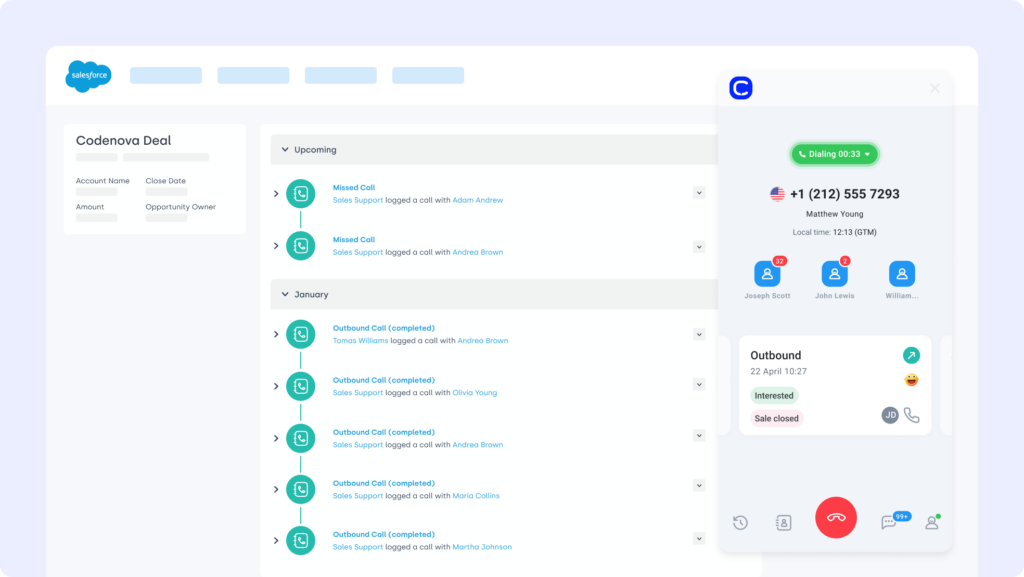
CloudTalk is a cloud-based VoIP phone system built for modern sales teams.
Make and receive calls directly within your CRM with a native Salesforce integration. All while automatically logging call data, notes, and recordings to the correct Lead, Contact, or Opportunity.
CloudTalk enhances outbound workflows with smart dialing, seamless call routing, and detailed analytics—all synced to Salesforce in real-time. It’s designed to streamline prospecting, follow-ups, and performance tracking.
Use case
An outbound SDR team uses CloudTalk to run daily cold call campaigns. With the Smart Dialer, agents automatically dial prioritized leads from Salesforce. Each call, note, and disposition is instantly logged, saving hours of manual data entry and improving CRM accuracy.
Key benefits
- Eliminate CRM switching with an embedded dialer
- Ensure complete call records for pipeline visibility
- Boost outbound volume with automation
- Improve ramp time and coaching with analytics
Key features
- Click-to-Call from Salesforce
- Automatic call logging & recordings
- Smart Dialer and Power Dialer
- Real-time call analytics and dashboards
Pricing
Plans start at $19, with a 14-day free trial and no credit card required.
Save your agents hours this week.
2. HubSpot
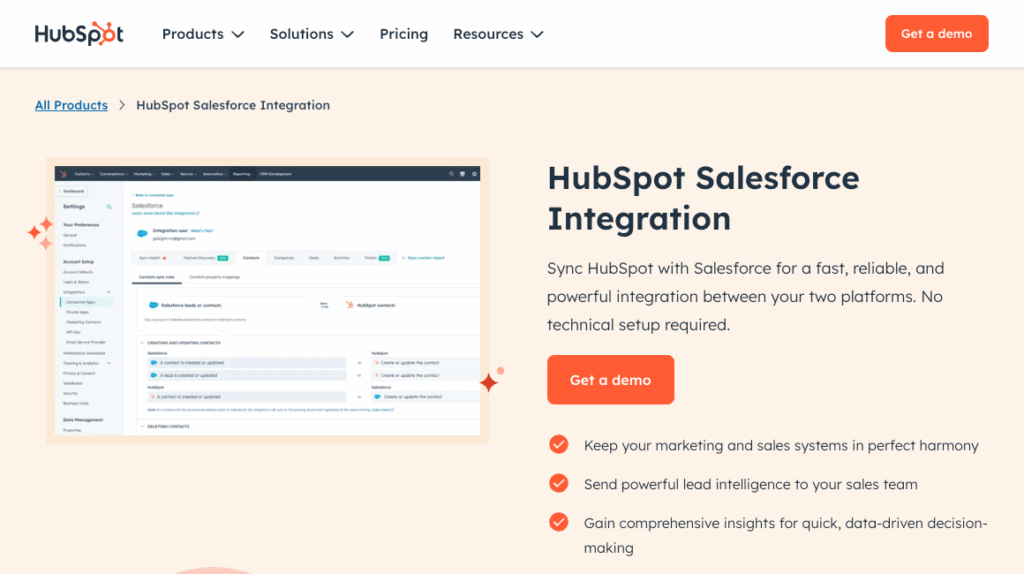
HubSpot is a powerful marketing automation platform that integrates directly with Salesforce to align marketing and sales workflows.
The bi-directional sync ensures that contacts, leads, and deal stages remain consistent between platforms. With HubSpot connected, marketing can nurture leads through email campaigns and workflows, while Salesforce keeps sales updated on engagement, lead scores, and hand-off readiness.
Use case
A B2B SaaS company uses HubSpot to run gated content campaigns. As leads download assets, their activity data syncs with Salesforce, alerting sales reps when prospects reach a score threshold. This leads to faster outreach and improved conversion rates.
Key benefits
- Seamless lead handoff between marketing and sales
- Improved visibility into buyer intent
- Consolidated reporting across both platforms
- No lead slips through the cracks
Key features
- Bi-directional contact and lead sync
- Workflow automation and lead scoring
- Email tracking and campaign analytics
- Custom field mapping
Pricing
Free CRM is available. Marketing Hub plans start at $20/month (Starter), with Salesforce integration in Pro+ tiers.
3. Cognism
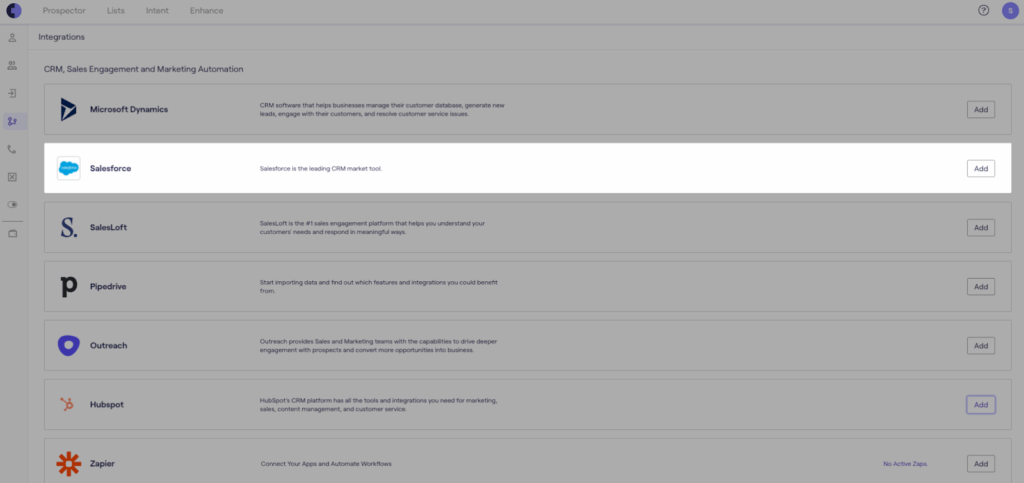
Cognism is a GDPR-compliant B2B contact data platform that integrates with Salesforce to enrich leads and accounts with verified business contact information.
The integration allows sales reps to instantly push Cognism-sourced contacts into Salesforce, complete with filmographies, direct dials, job titles, and intent data—helping reps prioritize the right prospects.
Use case
A sales development team targeting the UK market uses Cognism to identify new ICP leads. Once verified, they push them into Salesforce with one click. Salesforce workflows then assign the leads to SDRs, complete with phone numbers and LinkedIn profiles, speeding up outreach.
Key benefits
- Accurate, compliant contact enrichment
- Save hours on manual prospecting
- Push-to-Salesforce functionality
- More effective targeting and segmentation
Key features
- Real-time enrichment of Salesforce records
- Intent signal tracking
- DNC and GDPR compliance
- Custom list building by industry, region, or role
Pricing
Custom pricing based on team size and region. Demo required for quote.
4. Outreach

Outreach is a leading sales engagement platform that integrates deeply with Salesforce to automate multichannel cadences, streamline task execution, and enhance visibility into rep activity.
With the Outreach–Salesforce integration, reps can trigger workflows, log emails and calls, and update Salesforce records, without leaving their Outreach dashboard.
Use case
A sales team running outbound prospecting sequences uses Outreach to automate email follow-ups and call tasks. As prospects respond or go cold, Outreach updates the Salesforce Opportunity stage automatically, ensuring pipeline data stays accurate without manual input.
Key benefits
- Execute cadences without switching platforms
- Auto-log activities and outcomes to Salesforce
- Improve rep efficiency and task prioritization
- Gain real-time visibility into deal progress
Key features
- Multichannel sequence automation (email, call, LinkedIn)
- Salesforce field mapping & record syncing
- Opportunity and lead status updates
- Task management and analytics dashboards
Pricing
Custom pricing available upon request. Outreach typically caters to mid-sized and enterprise sales teams.
5. Gong

Gong is a conversation intelligence platform that records, transcribes, and analyzes sales calls and meetings. Its Salesforce integration ensures that insights from every sales interaction are automatically linked to the relevant Lead, Contact, or Opportunity.
Gong provides revenue leaders with deep visibility into deal health, rep performance, and pipeline risk.
Use case
A revenue operations team uses Gong to track sales calls and flag deals at risk based on talk ratios, competitor mentions, or stalled next steps. Salesforce Opportunities are auto-tagged with insights, enabling managers to proactively coach and intervene before deals go cold.
Key benefits
- Rich insights embedded directly in Salesforce
- Identify pipeline risks with AI-powered deal intelligence
- Coach reps using real call data
- Boost forecast accuracy and close rates
Key features
- Automatic call recording and transcription
- Deal boards synced to Salesforce
- Smart trackers for keywords and objections
- Forecasting and pipeline visibility tools
Pricing
Custom pricing. Typically sold in packages based on number of users and licenses (call recording required).
6. Juro

Juro is an intelligent contract management platform that integrates seamlessly with Salesforce to streamline the creation, approval, and management of legal agreements directly within the popular CRM.
Sales teams can generate compliant contracts in seconds from Salesforce Opportunities or Accounts, collaborate with legal in real time, and track contract status without leaving their workflow, ensuring faster deal cycles and complete visibility.
Use case
A Sales rep generates an MSA from an Opportunity record in Salesforce using Juro’s integration. Legal clauses and smartfields are auto-populated based on deal data stored in Salesforce, customizing the contract template and tweaking the terms to suit the deal size and criteria. The client can then send that for signing, negotiate directly in-browser, and sign electronically.
Key benefits
- Accelerate contract creation with template-driven automation
- Maintain compliance with standardized legal terms
- Keep deal progress visible with real-time contract status
- Shorten sales cycles with in-browser negotiation and eSignatures
Key features
- One-click contract generation from Salesforce records
- Smart templates with dynamic field population
- In-browser redlining and collaborative editing
- Real-time contract status syncing with Salesforce
- Native eSignature with full audit trails
Pricing
Salesforce integration is available on Juro’s Enterprise plan. Pricing is tailored based on the features required and the number of contracts managed.
7. PandaDoc
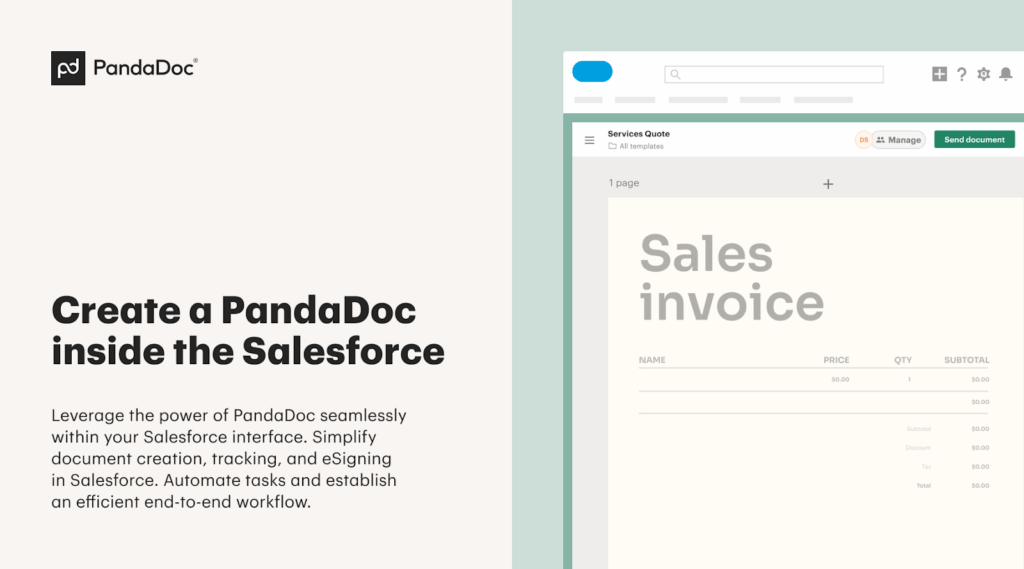
PandaDoc is a document automation and eSignature platform that integrates with Salesforce to simplify proposal, quote, and contract workflows.
Reps can generate personalized sales documents directly within Salesforce, track client interactions, and collect legally binding signatures without leaving the CRM, while ensuring version control and deal visibility.
Use case
A SaaS account executive uses PandaDoc to create a customized quote straight from an Opportunity in Salesforce. The client views and signs the document within minutes. PandaDoc automatically updates the deal stage in Salesforce and alerts the rep, reducing close time by days.
Key benefits
- Speed up quoting and contract processes
- Track views and engagement on every document
- Reduce errors with templates and auto-filled data
- Close deals faster with integrated eSignatures
Key features
- One-click document generation from Salesforce
- Dynamic templates with CRM field mapping
- eSignature tracking and real-time notifications
- Status syncing and deal automation
Pricing
Plans start at $19/user/month (Essentials); Salesforce integration is included in Business and Enterprise plans.
8. Asana
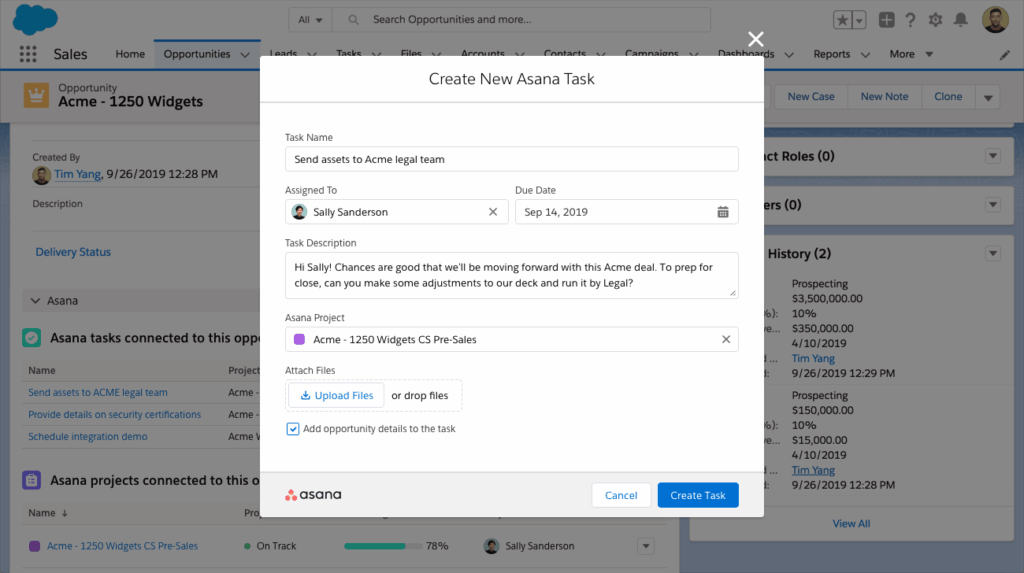
Asana is a collaborative project management tool that integrates with Salesforce to help sales, customer success, and RevOps teams manage onboarding, implementation, and post-sale workflows.
With the integration, users can automatically create Asana tasks and projects from Salesforce records, ensuring follow-through on critical deal-related action items.
Use case
After a deal is marked “Closed Won” in Salesforce, the integration triggers a templated onboarding project in Asana for the customer success team. This includes task assignments, timelines, and linked notes, keeping implementation on track without manual handoff steps.
Key benefits
- Automate post-sale workflows directly from Salesforce
- Improve collaboration across departments
- Reduce missed steps in onboarding or delivery
- Track progress on accounts in real time
Key features
- Task and project creation from Salesforce Opportunities
- Two-way updates between Asana and Salesforce
- Workflow rules based on CRM field triggers
- Templates for onboarding, renewals, and more
Pricing
Free plan available. Premium plans with Salesforce integration start at $10.99/user/month.
9. Slack

Slack is a real-time messaging platform that integrates with Salesforce to keep sales and customer-facing teams aligned through instant deal updates, alerts, and collaborative workflows.
The integration enables automated notifications in Slack channels based on Salesforce activity, such as new leads, closed deals, or changes in Opportunity stages.
Use case
A fast-growing sales org uses Slack to centralize deal updates. When an Opportunity hits “Proposal Sent” in Salesforce, a bot posts the update to the #deals channel, tagging legal and customer success for next steps—cutting internal email threads and speeding cross-functional action.
Key benefits
- Centralize CRM activity into Slack channels
- Improve team visibility and response time
- Reduce manual follow-ups and missed handoffs
- Foster faster decisions on deal progression
Key features
- Automated Salesforce alerts in Slack
- Deal status and account activity push notifications
- Lead routing and approval workflows
- Slash commands to look up records from Slack
Pricing
Slack offers free plans; Salesforce integration is included in Pro plans ($7.25/user/month) and up.
10. Mailchimp
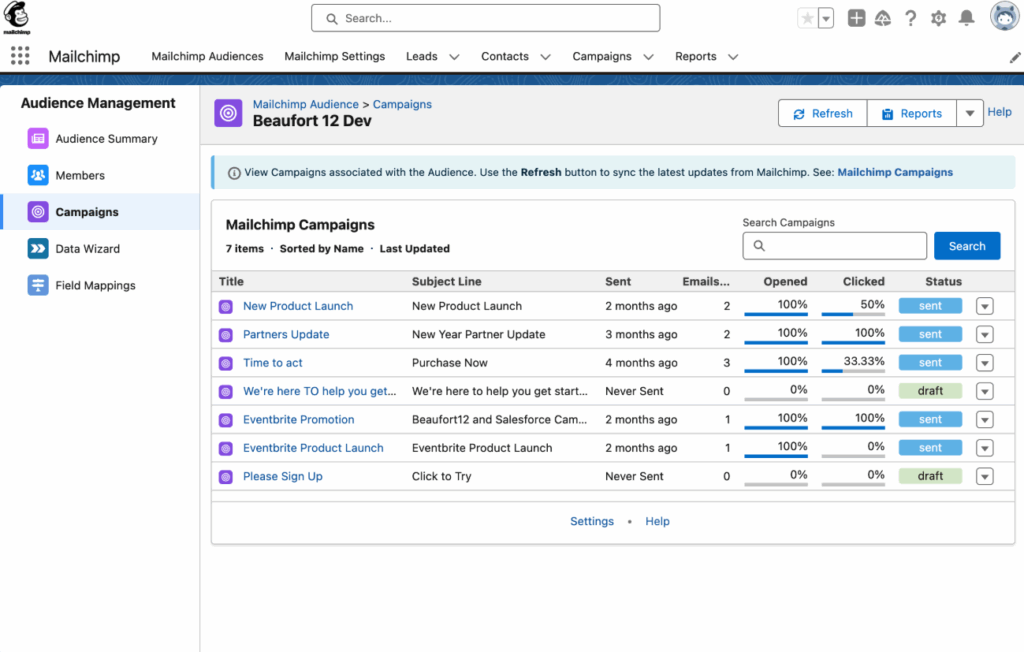
Mailchimp is an all-in-one email marketing platform that integrates with Salesforce to help businesses sync CRM contacts and create personalized, targeted email campaigns.
The integration allows marketers and sales teams to align on lead-nurturing strategies while maintaining up-to-date records across both platforms.
Use case
A growth team segments Salesforce contacts into cold, warm, and hot leads. These lists automatically sync with Mailchimp, where automated email sequences are triggered, from re-engagement campaigns to product announcements, helping sales reps focus only on the most engaged prospects.
Key benefits
- Sync Salesforce audiences into Mailchimp lists
- Automate email journeys based on CRM data
- Personalize campaigns using dynamic Salesforce fields
- Improve lead conversion and marketing ROI
Key features
- Bi-directional sync between Salesforce and Mailchimp
- Campaign performance tracking in Salesforce
- Triggered workflows tied to CRM stages
- Custom field mapping and segmentation
Pricing
Free plan available; paid plans with advanced automation start at $13/month. Salesforce integration requires a Pro or higher plan.
11. ZoomInfo

ZoomInfo is a B2B data and intelligence platform that integrates with Salesforce to enrich records with firmographics, contact details, intent signals, and technographic data.
The integration enables reps to discover new accounts, monitor buyer intent, and prioritize outreach, while keeping Salesforce leads and accounts fresh and actionable.
Use case
A sales team at an enterprise SaaS company uses ZoomInfo to identify companies showing intent around “sales automation.” When a company reaches a threshold, the lead is automatically enriched and synced to Salesforce, helping SDRs focus their energy on high-propensity prospects.
Key benefits
- Prioritize prospects with real-time intent signals
- Auto-enrich leads with direct dials and verified emails
- Maintain CRM data hygiene with up-to-date firmographics
- Surface new opportunities based on behavior, not guesswork
Key features
- Intent data tracking integrated with Salesforce
- Enrichment of leads, contacts, and accounts
- ICP list building with advanced filters
- Real-time alerts for buyer activity
Pricing
Custom pricing; generally suited for mid-market to enterprise sales teams. Demo required.
12. Google Sheets

Google Sheets integrates with Salesforce to enable custom reporting, ad hoc analysis, and spreadsheet-based automation. Whether through native connectors or middleware tools like Zapier or Coupler.io, this integration helps teams extract Salesforce data into Sheets for flexible manipulation or push updates back into Salesforce in bulk.
Use case
A RevOps manager exports Opportunity data from Salesforce into a Google Sheets dashboard shared with the VP of Sales. Using formulas and charts, they track conversion rates and build weekly pipeline forecasts without needing to set up complex Salesforce reports.
Key benefits
- Build dynamic dashboards outside Salesforce
- Easily share data with non-CRM users
- Perform custom calculations and data pivots
- Enable quick bulk updates via CSV or sync tools
Key features
- Export leads, opportunities, or activities to Sheets
- Auto-refresh schedules (hourly, daily, etc.)
- CSV import and sync back into Salesforce
- Compatible with Coupler.io, Zapier, Workato
Pricing
Google Sheets is free with a Google Workspace account. Middleware tools start at $49/month.
13. Front
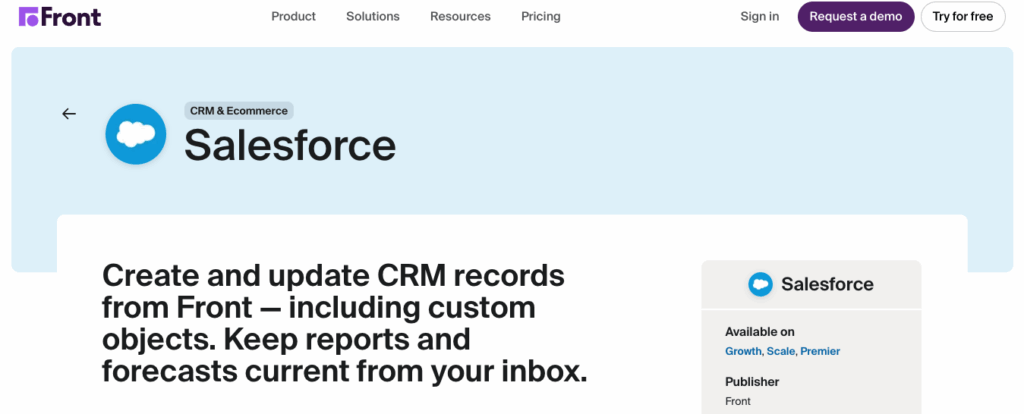
Front is a collaborative email and messaging platform designed for teams that manage shared inboxes (like sales@ or support@).
Its Salesforce integration allows reps to view and update CRM records directly from the Front interface, link emails to Leads or Opportunities, and personalize outreach using CRM context, without leaving the inbox.
Use case
An account management team handles customer renewals through a shared inbox. With the Salesforce integration, reps can see account value, status, and notes beside each message in Front, ensuring every reply is contextual, on-brand, and logged to the correct Opportunity.
Key benefits
- Centralize customer conversations in one inbox
- Reduce toggling between CRM and email tools
- Auto-log email threads to Salesforce records
- Improve collaboration and response time across teams
Key features
- View and edit Salesforce records from Front
- Customizable side panel with CRM fields
- Link conversations to Contacts, Leads, or Cases
- Rules and workflows to automate email routing
Pricing
Plans with Salesforce integration start at $59/user/month (Growth plan).
Now you know the best integrations. Time to give it a try.
Benefits of Salesforce Integration
Here’s how the right integrations give your team an advantage:
- Improve Data Accuracy: Automatically syncs calls, emails, and notes to Salesforce, ensuring clean CRM data and more accurate pipeline forecasts.
- Speed up Sales Cycles: Automate follow-ups, contracts, and task updates to shorten the sales cycle and reduce manual admin.
- Better Lead Scoring: Enrich leads with real-time data and intent signals to prioritize high-value prospects and personalize outreach.
- Streamline Sales Workflows: Run calls, emails, and tasks from one place — less tab-switching, more selling directly inside Salesforce.
- Boost Team Collaboration: Keep Sales, CS, and Ops aligned with deal alerts, shared inboxes, and automated task handoffs synced to Salesforce.
Every day without the right integrations is revenue left on the table.
How to Choose the Best Salesforce Integration
With 3,000+ apps in the Salesforce AppExchange, choosing the wrong integration can waste months and frustrate your team. Here’s how to pick winners every time:
1. Audit Your Team’s Pain Points (Start Here)
Before you fall in love with features, identify your biggest time-wasters. Ask your agents: “What manual task consumes the most selling time?”
Common answers are logging calls, updating deal stages, finding contact info, creating proposals, or chasing contract signatures.
Pick integrations that eliminate your #1 and #2 pain points first. Everything else is noise.
2. Run the “30-Second Test”
Great integrations feel invisible. If your agents can’t complete a core task within 30 seconds of opening Salesforce, the integration fails.
Test this during trials: Can they make a call? Send a personalized email? Update a deal stage? If it takes longer than 30 seconds, keep looking.
3. Demand Real-Time Data Sync
If it doesn’t sync both ways in real-time, it’s not worth your time. Your agents shouldn’t wonder if Salesforce has the latest information. Ask vendors specifically: “If I update a contact in your tool, does it appear in Salesforce within 60 seconds?” If they hesitate, move on.
4. Evaluate Scalability Limits
Think 3x growth. If your team triples in size next year, will this integration still work? Check these red flags:
- Per-seat pricing that explodes with growth
- “Contact support for more than 50 users”
- No admin controls for different team roles
- Single-region limitations
If any apply, the integration will become a bottleneck.
5. Challenge Their Support Team
Great tools with terrible support are terrible tools. During your trial, test their support response time with a real question. If it takes more than 24 hours to get a helpful answer, imagine the frustration during a critical rollout.
Look for: Live chat, phone support, comprehensive documentation, and video tutorials.
6. Calculate Your True ROI
Skip complicated ROI calculators. Use this simple test: If this integration saves each rep 30 minutes per week, and your reps make $100K annually, it’s worth up to $780 per rep per year (30 min × 52 weeks × $25/hour).
If the annual cost is less than that number × your team size, it’s probably worth it.
How to Integrate Salesforce with Other Platforms?
Salesforce offers several integration methods, each suited to different team sizes, technical skills, and customization needs.
Here’s a quick breakdown to help you choose the best option:
- AppExchange: Salesforce’s official marketplace offers thousands of pre-built integrations. Simply install the app, authenticate it, and start syncing — ideal for sales teams wanting fast, plug-and-play solutions.
- Native Integrations: These are built-in connections between Salesforce and trusted platforms like CloudTalk or Slack. Setup is typically one-click, with reliable sync and minimal maintenance required over time.
- API & Webhooks: For advanced teams, Salesforce’s REST and SOAP APIs allow for custom, highly tailored integrations — syncing data in real time or triggering workflows from external systems.
- Third-party Tools: Platforms like Zapier, Make, or Workato offer no-code integration layers. These are great for automating tasks between Salesforce and apps that lack native support.
- Pro Tip: Always test integrations in a Salesforce sandbox before going live. It helps avoid data mismatches, sync errors, or disruptions to existing workflows.
Transform Your Sales Process Starting Today
You’ve seen the 12 integrations that turn ordinary Salesforce setups into deal-closing powerhouses. Each one eliminates a specific bottleneck that’s costing you deals right now.
Stop losing leads to poor data quality. Stop wasting time on manual call logging. Stop falling behind competitors who’ve already connected tools like CloudTalk to their Salesforce CRM.
The choice is simple: Keep using Salesforce as just another database, or transform it into an automated revenue engine like thousands of other sales teams.
Your free demo is waiting. Your competition isn’t.









